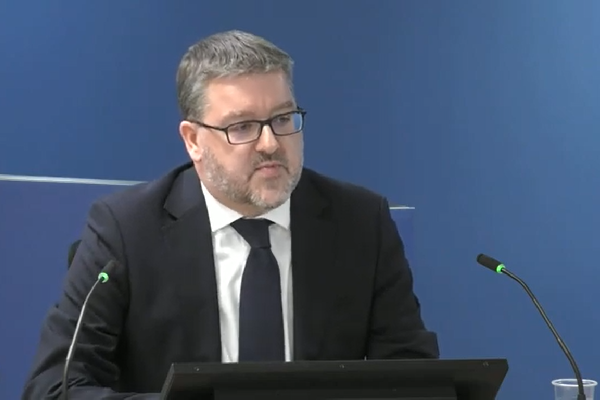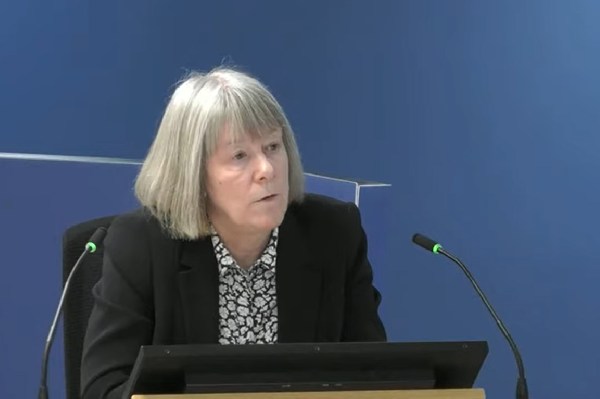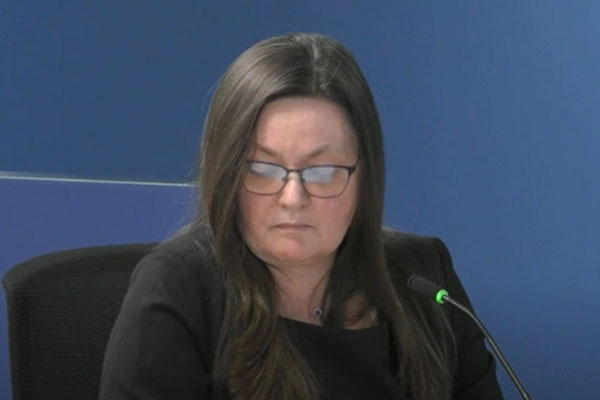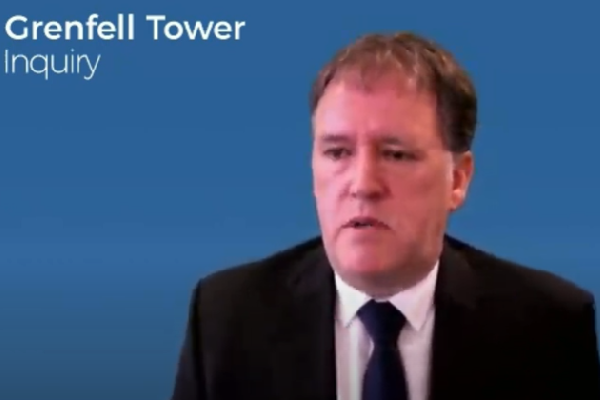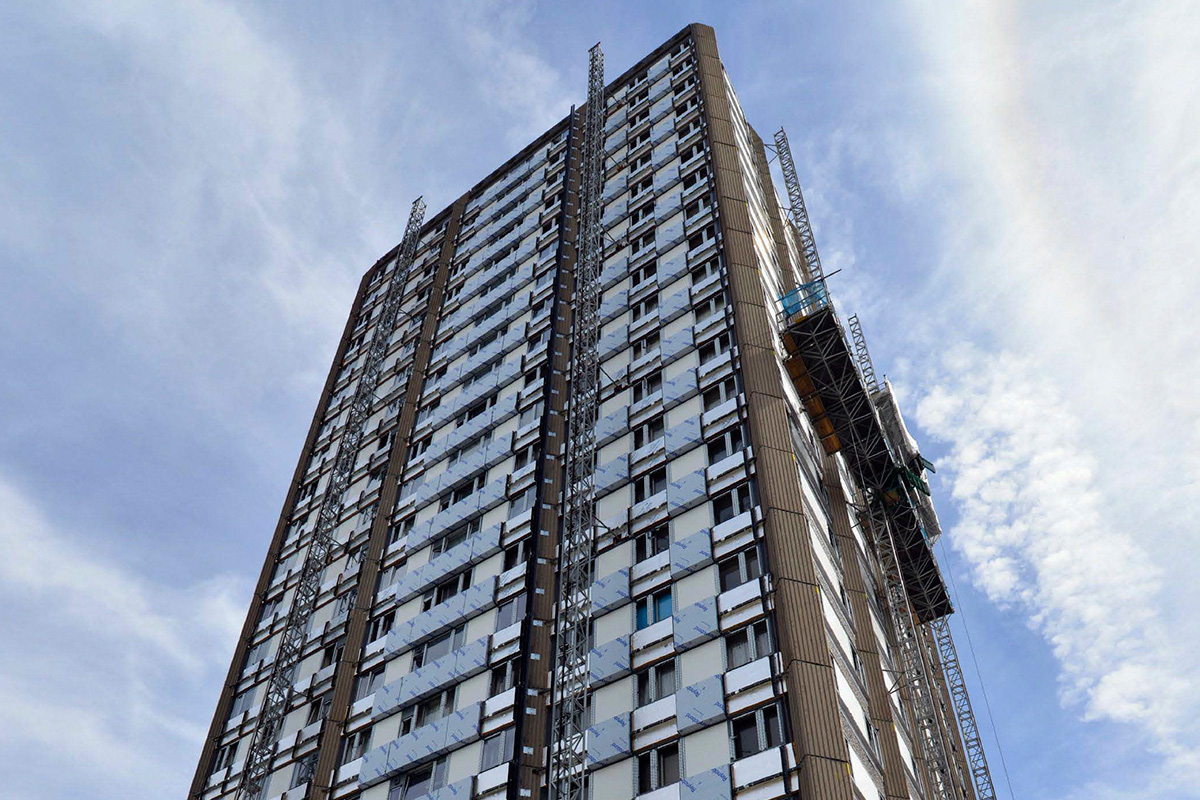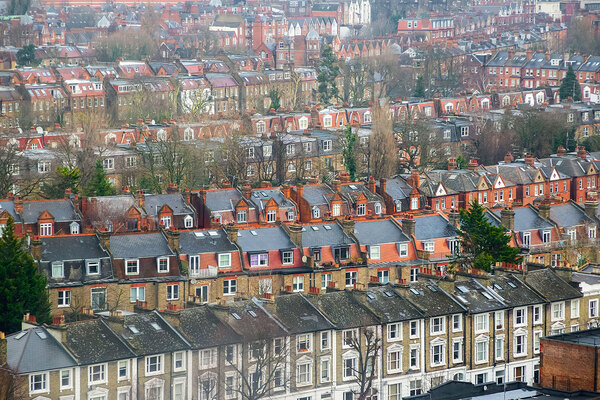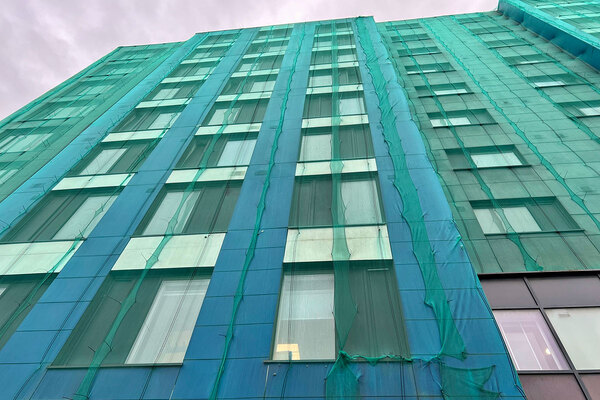Grenfell Tower Inquiry diary week 65: ‘Unless the government does something now about ACM panels, people will die’
Further evidence from the Building Research Establishment (BRE) and the first government witnesses added new depth to our understanding of how warnings were missed before the Grenfell Tower fire. Peter Apps reports
Once more, the primary focus of this week’s evidence at the Grenfell Tower Inquiry was the failure by successive governments to tighten building regulations guidance sufficiently to clearly ban the cladding material later used on the tower.
Much of this surrounds the continuing use of ‘Class 0’ as the minimum standard for external wall surfaces, despite knowledge since the early 1990s that the standard was insufficient to prevent the use of dangerous materials.
This question was explored with former senior official Anthony Burd, who began his evidence yesterday, and Dr Dr Debbie Smith, former managing director of the BRE, who was in the witness box for three and a half days before him.
We begin our recap with Mr Burd.
‘Have you any inkling as to why those amendments, those excisions from the text, were made?’
The story begins in the 1990s when – as the inquiry has previously heard – two tower block fires, one in Knowsley Heights in Merseyside in 1991 and one in Garnock Court, Ivrine, Scotland in 1999, caused concern about the rising use of combustible materials on the outside of tall buildings.
The BRE’s report into the Knowsley fire identified that the building had been clad with a combustible plastic which met the standard of Class 0 and was therefore compliant with the rules.
We have also heard that the report drew no real attention to this, and even implied that the cladding system was actually non-combustible.
In 1999, the BRE was commissioned to prepare two reports into the Garnock Court fire: one for North Ayrshire Council, which owned the block, and one for the government.
Mysteriously, these two reports were different. The North Ayrshire Council report contained several references to Class 0, but these were purged from the copy sent to the government.
“Have you any inkling as to why those amendments, those excisions from the text, were made?” asked lead counsel to the inquiry Richard Millett QC.
“I do not,” replied Mr Burd (pictured above), a former head of technical policy in the department now known as the Department for Levelling Up, Housing and Communities.
“Can we safely conclude that whoever made the decision to excise those passages… were either people in the BRE or people in government?” asked Mr Millett.
“Given that is who the documents went to, yes,” replied Mr Burd.
The issue of the danger from combustible cladding was then investigated by a select committee in 1999. This committee was presented with evidence of the danger of Class 0 by industry experts.
As a result, its report effectively recommended the end of reliance on the standard. Cladding systems should either be entirely non-combustible or justified through the evidence of a test on the entire system.
But this is not what the government did. Instead, it kept the Class 0 standard and introduced the testing as an alternative.
“Are you able to offer any insight as to why that advice was rejected?” asked Mr Millett.
“I am not, sir,” replied Mr Burd.
Mr Burd continues his evidence on Monday.
‘Members expressed concern that the UK would become a “dumping ground” for inferior products that could not be sold in other member states’
The select committee report was not the only opportunity the department had at this time to ditch its reliance on Class 0.
In the early 2000s, the European Union had developed new fire tests which graded materials alphabetically from A1 (the best) to E (the worst) and represented a more sophisticated testing method than the British standards that underpinned Class 0.
The UK was supposed to transition to these standards to harmonise with the rest of Europe.
“Members expressed concern that, if the UK were to continue [without harmonising standards], it would become a ‘dumping ground’ for inferior products that could not be sold in other member states,” minutes of one meeting between officials and industry representatives records.
But not all the industry representatives wanted the standards raised. It was noted, for example, that combustible insulation products which could obtain a Class 0 rating by virtue of their foil facing would not be able to achieve Euroclass B, which was set to be introduced as the equivalent.
An email from the industry's lobbying group warned that such products could be “prevented from continuing” and said the move to European standards therefore “should not happen”.
Nonetheless, the government appears to have resolved to go ahead with the change. Minutes showed it intended to enter a transition phase where both Euroclass B and Class 0 were acceptable. It would then require Euroclass B for all new products entering the market, before ultimately making the European standard the only relevant requirement and withdrawing the British standard.
This was due to take around three years – but it never happened.
Instead, the transition period, with both Class 0 and Euroclass B applicable, continued until 2018 – a year after the Grenfell fire.
“Do you know why [the transition plan] was abandoned?” asked Mr Millett.
“No,” replied Dr Smith (pictured above).
“Was any consideration given to the risks to life presented by leaving Class 0 in the [guidance] in this way?” asked Mr Millett.
“Not at that time, I don’t believe so, no,” replied Dr Smith.
In May 2003, a pamphlet produced by insulation manufacturer Kingspan said: “Government has stated that it will not implement the new Euroclass system until industry is ready for it.”
Dr Smith said she was surprised by the document and could not explain it.
‘Unless the government does something now about ACM panels, people will die. I mean, that’s clear isn’t it?’
As part of its contract to develop the large-scale test endorsed by the select committee, the BRE was required to carry out a “comprehensive survey” of cladding systems in use in the UK.
It did so with a questionnaire sent to local authorities. This produced only 13 responses. Dr Smith explained that it was “very difficult to get busy people to see the need to respond” to a survey of this nature.
But combining these responses with data from the trade press about materials on the market, the BRE designed 14 tests on various cladding systems to examine its proposed test methodology.
Among these systems was one including an aluminium composite material (ACM) panel, with a Class 0 rating.
When it was tested on 18 July 2001, this system performed catastrophically badly. Flames ripped through the nine-metre test rig in just five minutes, with flames extending 20 metres into the air. The test was halted to protect the safety of those present. While several other systems failed, none came close to the horrifying flame spread seen in this test.
The BRE then summarised the findings of the testing in a report for government in September 2002.
“Can we be clear about one thing: that your evidence to the inquiry is that from the middle of September 2002, the government was in no doubt at all that ACM panels with a [polyethylene] core should never ever be used [on buildings] above 18 metres?” asked Mr Millett (pictured above).
“Within that context of [the new testing methodology being developed], yes,” Dr Smith replied. “So the extent to which they were prepared to accept [that testing] as being representative.”
Surely now, in the knowledge of the risks that could be posed by Class 0 rated materials, the government needed to urgently amend its guidance to remove the standard immediately?
The BRE’s report did not spell this out. Instead, it simply said the material “proved to be one of the worst performing products” and added that “these issues require further consideration”.
“You see, Dr Smith, what you don’t do in this report is to spell out in big letters… that unless the government does something now about ACM panels over 18 metres, people will die. I mean, that’s clear isn’t it?” asked Mr Millett.
“Well it was not put in those terms. I haven’t seen any BRE report that ever speaks in those terms,” said Dr Smith. “Because our role is to present the technical evidence and the technical facts and the data and then to signal what we think needs to be considered.”
It was the ACM that would later be used on Grenfell Tower. The inquiry has already established it to have been the primary cause of the rapid fire spread.
Following the testing programme, the BRE received a letter in August 2002 from industry body the Centre for Window and Cladding Technology (CWCT) which warned that the new testing methodology was too tough on cladding systems.
The letter said that it was concerned the test could lead to “the abandonment” of the use of rainscreen cladding systems, adding that “if this occurs there could be economic consequences for the building industry and the UK as a whole”.
In the margins, a handwritten note from Dr Smith suggested amending the test methodology to make clear that fire barriers could “improve performance”.
“Was this suggestion a sop to industry?” asked Mr Millett. “It’s an encouragement isn’t it, that if you don’t pass, fire barriers might help?”
“Well, you should be incorporating fire barriers anyway,” said Dr Smith.
‘It was one of absolute shock and wondering how on earth that could have happened’
In 2006, the government did amend guidance in Approved Document B. The effect of this amendment is a critical and hotly contested issue.
It followed a fire in Salford at a building called The Edge in 2005. The blaze spread through sandwich panels on the external wall filled with an insulation material between two thin sheets of metal.
This caused some concern. The panels were Class 0, but plainly flammable.
As a result, Approved Document B was amended to extend a paragraph which required ‘limited combustibility’ insulation in certain circumstances to cover “any insulation product, filler material… etc”.
Limited combustibility is a far tougher standard than Class 0, and would have ruled out the kind of flammable products used on Garnock Court, Knowsley Heights, the Edge and later Grenfell Tower.
But the problem is that the other passage in the guidance including Class 0 was not removed.
So now, Approved Document B contained two standards: one for “insulation products, filler material… etc” and one for “external surfaces”.
The huge question is which of these standards should have applied to the external cladding panel.
Cladding is plainly not insulation. It keeps the building dry and improves its aesthetic, but does nothing to keep it warm. Government figures have argued since the fire that ‘filler material’ should have included the plastic in between the sheets in an ACM product. But was this true? And was it clear?
Dr Smith said she believed that following this change, every component of an external wall had to be ‘limited combustibility’. Although, under questioning, she revised this to say that it would not have applied to the external coating or face of a cladding product.
As a result of this, she claimed that her reaction after the Grenfell Tower fire to learning that combustible products were still in wide use on facades “was one of absolute shock and wondering how on earth that could have happened”.
But how does that claim stack up with the evidence of what happened in the years between 2006 and 2017?
‘What I’m really asking you to explain is whether you can provide a good reason for your complete inability to remember anything’
In March 2012, for example, Dr Smith suggested in an email that requirements for separation between buildings could be increased “due to highly insulated buildings and combustible facades”.
“Why were you even discussing combustible façades in circumstances where your understanding was that there couldn’t be any because of your reading of Approved Document B?” asked Mr Millett.
Dr Smith claimed she was mainly referring to the niche practice of growing plants on walls of buildings, which could sometimes go dry when not sufficiently watered.
On top of this, her colleagues at the BRE were repeatedly warned that the Class 0 rating meant ACM panels were in wide use in the UK.
In fact, Dr Sarah Colwell (pictured above) – who gave evidence last week – was invited to a meeting with the CWCT and other experts to discuss the issue in July 2014.
At the meeting, she was told that ACM was in wide use and the guidance was not sufficiently clear to ban it. She agreed to draft a frequently asked question (FAQ) to make clear that it should not be used.
But she decided not to produce this FAQ – and in her evidence last week said this decision was made in collaboration with Dr Smith.
Dr Smith said this surprised her. “I don’t recall that at all... I’m amazed that that’s her recollection of that.”
The BRE would be further warned by Nick Jenkins, who worked at cladding firm Booth Muirie, that the product was in wide use in the UK. This provoked an exchange of emails on the topic with the government. Dr Smith said she could recall none of this.
“What I’m really asking you to explain is whether you can provide a good reason for what appears to be your complete inability to remember anything about this exchange or this issue or these questions?” asked Mr Millett.
“I don’t think this was brought to my attention,” she said.
‘Did you reach an agreement with Brian Martin before this meeting that you would give away the barest minimum of information to the minister?’
All of this is particularly important because three days after the Grenfell Tower fire in 2017, Dr Smith was invited to a meeting with new housing minister Alok Sharma (pictured above) to advise on the government’s response.
One of the critical issues he wanted advice on was whether Grenfell was likely to be an “isolated incident” or if many other buildings around the UK were impacted.
Had Dr Smith had known about the warnings issued to the BRE in the preceding years that the dangerous cladding on the tower was widely used, she surely should have told him. But she did not.
In fact, she did not even tell him her belief that until 2006 the material was entirely acceptable under official guidance.
“It would have been a direct answer to a direct question: is Grenfell a one-off? Why didn’t you say it can’t have been a one-off because the regulations were only tightened up in 2006 to ban all combustible materials from the external wall?” asked Mr Millett.
“It’s not something that occurred to me at the time, given the nature of the discussions that were going on in that meeting,” she replied.
Neither did she mention the 2001 test on ACM, despite the meeting directly seeking information on why the fire had spread so rapidly. She said this would have been “speculation”.
“No, it wouldn’t, Dr Smith. It wouldn’t have been speculation. It was a fact... Why not tell the minister that [test] had happened and that the government had the records of that?” asked Mr Millett.
Dr Smith said she did not believe it was relevant, as the test may have been on a different system to the one on Grenfell Tower.
Also at the meeting was Brian Martin, the senior official responsible for building guidance. Some of the warnings about ACM were issued directly to him and he too was aware of the 2001 test. But Dr Smith said he did not mention them at the meeting either.
He will surely be asked to explain why when he gives evidence in the coming weeks.
The email trail revealed that Dr Smith and Mr Martin had spoken the day before the meeting, as Dr Smith travelled back to the UK on a Eurostar to attend.
“Did you reach an agreement with Brian Martin before this meeting that you would speak only when spoken to and give away the barest minimum of information to the minister?” asked Mr Millett.
“Absolutely not,” replied Dr Smith.
‘What system was put in place to make sure that Phil Clark didn’t take things out of the hard copy files and destroy them?’
Throughout Dr Smith’s evidence, she was also asked about several issues relating to the BRE’s testing of cladding systems containing insulation on behalf of Kingspan and Celotex, the firms which sold their products for use on Grenfell Tower.
We do not have space here to recount all of those issues, although one new email was revealed which showed Dr Smith agreeing to sit down with Kingspan and “work with them to design a progressive programme of testing” on their products in 2008.
This appears to contradict the firm’s rules about strict impartiality and not providing advice to clients.
“Some people reading that email might think that here was the BRE cosying up to its clients for financial gain. Do you have a comment on that?” asked Mr Millett.
“No, I don’t believe that to be the case,” Dr Smith said.
She was also asked a startling series of questions about her colleague Phil Clark (pictured above), who was in charge of the laboratory where the tests were carried out. He was given access to the files relating to this period in preparing for his statement for the inquiry.
But there have been crucial documents the inquiry has been unable to find, such as the delivery note for fire resisting boards installed onto a Celotex test rig and never declared in the report.
“What system was put in place to make sure that Phil Clark didn’t take things out of the hard copy files and destroy them, to be blunt?” asked Mr Millett.
“I don’t know how he could possibly have done that, because he was in a room with nothing in there other than a desk and a chair,” she replied.
“I think the point Mr Millett is inviting you to consider is this: what was there to prevent Phil Clark from taking a piece of paper out of the file and slipping it into his pocket?” asked inquiry chair Sir Martin Moore-Bick.
“Well, insofar as nobody sat there and actually watched him 100% of the time, I can’t, you know, I can’t comment on that,” Dr Smith replied.
Asked at the end of her evidence if she would have done anything differently, Dr Smith asked to submit a written statement instead as her questioning had been “quite tiring”.
“I don’t think a submission will answer my question. I would like to have your reflections, even though they may be off the cuff, on oath in public now, please,” said Mr Millett.
“Well, I really − I’m not prepared − I haven’t prepared an answer to that. And I’m ... I just feel sort of exhausted by this process and I don’t feel that that’s − that I can really directly answer you right now,” she said.
The inquiry continues with further evidence from Mr Burd and other officials next week.
Grenfell Tower Inquiry – week 65 headlines
BRE manager did not tell government about failed cladding tests in aftermath of Grenfell fire
A former managing director at the Building Research Establishment did not tell an emergency meeting convened by government in the days after the Grenfell Tower fire that official tests had revealed the risk of the tower’s cladding material 16 years earlier.
Former BRE manager denies being more concerned about money than safety
A former Building Research Establishment manager denied being more concerned about money than safety, after an email showed her fretting about the loss of the company’s “fire safety mantle” to “a competitor” if it helped prepare joint industry guidance on dangerous cladding.
Government was warned UK faced becoming ‘dumping ground’ for combustible construction products
The government was warned in the early 2000s that the UK risked becoming a “dumping ground” for inferior construction products if tougher European fire standards were not implemented, but did not transition to them amid pressure from industry lobbyists.
The “catastrophic” result of an official cladding test meant the government was “in no doubt at all” that the violently combustible material later installed on Grenfell Tower “should never ever” be used on tall buildings from as early as 2002, the inquiry into the blaze heard.
Sign up for our weekly Grenfell Inquiry newsletter
Each week we send out a newsletter rounding up the key news from the Grenfell Inquiry, along with the headlines from the week
Already have an account? Click here to manage your newsletters
Grenfell Tower Inquiry phase two: weekly diaries
Module one: the refurbishment
Week one: A vivid picture of a broken industry
After a week of damning revelations at the opening of phase two of the Grenfell Tower Inquiry, Peter Apps recaps the key points
Click here to read the full story
Week two: What is the significance of the immunity application?
Sir Martin Moore-Bick has written to the attorney general requesting protection for those set to give evidence at the Grenfell Tower Inquiry. Peter Apps explains what the move means
Click here to read the full story
Week three: Architects of misfortune
This week saw the lead architects for the Grenfell Tower refurbishment give evidence to the inquiry. Peter Apps runs through the key points
Click here to read the full story
Week four: ‘I didn’t have any perception that it was the monster it’s become’
The architects continued to give evidence this week, outlining a lack of understanding of the fire risk posed by the cladding materials and its design. Nathaniel Barker reports
Click here to read the full story
Week five: ‘No adverse effect in relation to external fire spread’
As the Grenfell Tower Inquiry returns from its long absence, Peter Apps recaps the key points from a week of important evidence from the fire consultants to the refurbishment
Click here to read the full story
Week six: ‘I can’t recall any instance where I discussed the materials with building control’
Nathaniel Barker summarises what we learned from fire engineers Exova, architects Studio E and the early evidence from contractor Rydon
Click here to read the full story
Week seven: ‘I do not think I have ever worked with a contractor operating with this level of nonchalance’
Two key witnesses from contractor Rydon gave evidence this week. Peter Apps recaps some of the key points from a revealing week of evidence
Click here to read the full story
Week eight: ‘It haunts me that it wasn't challenged’
Four witnesses from contractor Rydon gave evidence this week. Lucie Heath recaps what we learned on the last week of evidence before the inquiry breaks for five weeks
Click here to read the full story
Week nine: ‘All I can say is you will be taken out for a very nice meal very soon’
This week the inquiry heard evidence from witnesses at Harley Facades, the sub-contractor responsible for Grenfell Tower’s cladding. Peter Apps recaps the key points
Click here to read the full story
Week 10: ‘As we all know, ACM will be gone rather quickly in a fire!’
As the Grenfell Tower Inquiry entered its 10th week, Jack Simpson recaps the key points from a week of important evidence from the refurbishment’s cladding contractor
Click here to read the full story
Week 11: ‘Did you get the impression Grenfell Tower was a guinea pig for this insulation?’
With witnesses from the cladding subcontractor, the firm which cut the deadly panels to shape and the clerk of works which inspected the job giving evidence this was week full of revelations. Peter Apps recaps the key points
Click here to read the full story
Week 12: ‘Would you accept that was a serious failing on your part?’
With the surveyor who inspected Grenfell Tower for compliance giving evidence, this was a crucial week from the inquiry. Dominic Brady and Peter Apps report
Click here to read the full story
Week 13: ‘Value for money is to be regarded as the key driver for this project’
With consultants to Kensington & Chelsea Tenant Management Organisation (KCTMO) giving evidence, attention at the Grenfell Tower Inquiry turned for this first time to the actions of the TMO and the council. Peter Apps reports
Click here to read the full story
Week 14: ‘Did it not occur to you at this point that your budget was simply too low?’
This week, for the first time in phase two, the inquiry heard from Kensington & Chelsea Tenant Management Organisation, the landlord that oversaw the fatal refurbishment of Grenfell Tower. Lucie Heath reports
Click here to read the full story
Week 15: ‘Have you ever informed the police that you destroyed documents relevant to their investigation?’
Witnesses from the Kensington and Chelsea Tenant Management Organisation (KCTMO) gave evidence for a second week, which began with a shocking revelation about withheld and destroyed evidence. Peter Apps recaps
Click here to read the full story
Week 16: ‘I conclude this was very serious evidence of professional negligence’
This week saw members of Kensington & Chelsea Tenant Management Organisation finish giving evidence, before the inquiry’s expert witnesses took the stand to make some highly critical assessments of the work they had seen before and during the refurbishment of Grenfell Tower. Jack Simpson recaps
Click here to read the full story
Grenfell Tower: a timeline of the refurbishment
Following the conclusion of module one of the Grenfell Inquiry’s second phase, Peter Apps presents a timeline of the key moments during the fatal refurbishment of the west London tower block
Click here to read the full story
Module two: the cladding products
Week 17: ‘It’s hard to make a note about this because we are not clean’
The start of the second module of the Grenfell Tower Inquiry phase two came with some huge revelations about the companies that sold the products used in the cladding system. Peter Apps reports
Click here to read the full story
Week 18: ‘It was just reckless optimism wasn't it?’
As the inquiry began cross-examining witnesses for the second module of its phase two work, the picture surrounding just how Grenfell Tower ended up wrapped in such dangerous materials became a little clearer. Nathaniel Barker was keeping an eye on proceedings
Click here to read the full story
Week 19: ‘And that was intentional, deliberate, dishonest?’
The Grenfell Tower Inquiry this week heard the shocking story of how the insulation manufacturer “manipulated” official testing and marketed its product “dishonestly”. Peter Apps tells the story
Click here to read the full story
Week 20: ‘We were outed by a consultant who we then had to fabricate a story to’
This week the inquiry investigated the actions of Kingspan – the manufacturer of one of the insulation products used in the tower’s cladding system. Dominic Brady reports
Click here to read the full story
Week 21: ‘It’s there in black and white isn't it? We see a complete absence of any consideration of life safety’
The story of insulation giant Kingspan’s testing and marketing of its combustible insulation for high rises was unpacked in minute detail this week. Peter Apps reports
Click here to read the full story
Week 22: ‘All we do is lie in here’
In the third week of evidence from insulation giant Kingspan, the inquiry continued to uncover shocking details about the firm’s behaviour both before and after the Grenfell Tower fire. Lucie Heath reports
Click here to read the full story
Week 23: ‘That would have come as an earthquake to you at the time, would it not?’
This week the inquiry took its deepest dive yet into the inner workings of the cladding manufacturer whose product has been blamed for the terrible spread of fire up Grenfell Tower. Nathaniel Barker reports
Click here to read the full story
Week 24: ‘Do you accept that Test 5B was Arconic's deadly secret’
The president of the firm that made and sold the cladding panels installed on Grenfell Tower was asked to account for the apparent concealment of “disastrous” fire tests on the product this week. Peter Apps reports
Click here to read the full story
Week 25: ‘This is quite an incredible list of omissions and missed instances, isn’t it?’
This week the Grenfell Tower Inquiry heard its first witnesses from the Building Research Establishment (BRE) - the testing house which carried out key fire tests on the Kingspan and Celotex insulation products which were later used on Grenfell Tower. Peter Apps reports.
Click here to read the full story
Week 26: 'You were taking an enormous risk, weren't you?'
Week 26 at the Grenfell Tower Inquiry was a key moment in understanding how dangerous products used on the tower came to be accepted by industry professionals. Dominic Brady reports
Click here to read the full story
Week 27: ‘What will happen if one building made out [of] PE core is in fire and will kill 60 to 70 persons?’
The most explosive evidence this week at the Grenfell Tower Inquiry came from those who did not attend, as the evidence which would have been presented to Arconic witnesses was displayed in their absence. Peter Apps reports
Click here to read the full story
Week 28: ‘This is a serious safety matter’
This week the Grenfell Tower Inquiry zeroed in on the British Board of Agrément, the body that produced “misleading” certificates which inspired trust in both the cladding and insulation used on the tower. Lucie Heath reports
Click here to read the full story
Week 29: ‘Is it true that Kingspan’s position… was to do its best to ensure that science was secretly perverted for financial gain?’
The final week in this section of the Grenfell Tower Inquiry primarily examined the attempts by insulation manufacturer Kingspan to lobby government after the fire. Peter Apps reports
Click here to read the full story
How the products used in Grenfell Tower's cladding system were tested and sold
As the section of the Grenfell Tower Inquiry examining how the products used in the cladding system were tested, marketed and sold comes to a close, Peter Apps summarises what we have learned about each of the products included in the system
Click here to read the full story
Module Three: the management of the tower
Week 30: ‘There is certainly a high probability that in the event of a fire the whole building can become an inferno’
The focus of the inquiry shifted this week to the actions of the social housing providers responsible for maintaining Grenfell Tower. Pete Apps recaps what we learned
Click here to read the full story
Week 31: ‘If we cannot get out people will die’
This week saw the former residents of Grenfell Tower enter the witness box to tell of their experiences attempting to raise complaints with the council and its managing agent. Pete Apps reports
Click here to read the full story
Week 32: ‘Let's hope our luck holds and there isn't a fire’
This week saw the return of the landlord of Grenfell Tower, Kensington and Chelsea Tenant Management Organisation (KCTMO), as senior staff members attempted to explain how vital fire safety protections at the block were allowed to fall into disrepair. Lucie Heath reports
Click here to read the full story
Week 33: ‘Isn't that a serious gap in the scope of a policy meant to safeguard vulnerable people?’
A slightly disjointed week at the Grenfell Tower inquiry saw further evidence from staff at building manager Kensington and Chelsea Tenant Management Organisation (KCTMO) interspersed with the views of a cladding expert. Peter Apps reports
Click here to read the full story
Week 34: ‘Some members of the community are doing their best to spread false information’
Jack Simpson covers all the major revelations from the past week of evidence at the Grenfell Inquiry, including evidence from Laura Johnson, director of housing at the Royal Borough of Kensington and Chelsea.
Click here to read the full story
Week 35: ‘I really didn’t like the champagne’
This week the Grenfell Tower Inquiry saw council witnesses, including former deputy leader Rock Feilding-Mellen and leader Nicholas Paget-Brown, questioned about their role in the story for the first time. Peter Apps reports
Click here to read the full story
Week 36: ‘Is that not a very incurious approach for a fire risk assessor?’
This week the Grenfell Tower Inquiry scrutinised the work of Carl Stokes, the man hired to carry out fire risk assessments for the block. Nathaniel Barker reports
Click here to read the full story
Week 37: ‘In giving that advice, weren’t you acting beyond your knowledge and expertise?’
A curtailed week at the Grenfell Tower Inquiry saw fire risk assessor Carl Stokes grilled over advice he gave regarding the tower’s cladding. Peter Apps reports
Click here to read the full story
Week 38: ‘Well it’s a bit more than that, isn’t it. He’s suggesting that you tell the LFB a lie’
The inquiry heard the mammoth cross-examination of KCTMO’s health and safety manager Janice Wray this week. Peter Apps reports
Click here to read the full story
Week 39: ‘What you said there was a grotesque understatement’
This week the inquiry continued to hear from former employees of Kensington and Chelsea Tenant Management Organisation, as well as two employees from the London Fire Brigade. Lucie Heath reports
Click here to read the full story
Week 40: ‘An exercise in concealment and half-truth’
Former KCTMO chief executive Robert Black gave his evidence to the inquiry this week and was asked to account for the various failures described over the previous six weeks. Peter Apps and Nathaniel Barker report.
Click here to read the full story
Week 41: ‘We should do nothing. This is not the sort of website we should be responding to’
This week saw the return of Robert Black, chief executive of Kensington and Chelsea Tenant Management Organisation (KCTMO), before the inquiry turned its attention to the defective smoke control system in the tower. Dominic Brady reports
Click here to read the full story
Week 42:‘They would leak as much as they leaked. They were what they were’
The Grenfell Tower Inquiry continued its in-depth investigation of the tower’s non-compliant smoke control system this week, with evidence from the various contractors involved in delivering it. Pete Apps reports
Click here to read the full story
Week 43:‘Contractors at the time were not generally aware of the importance of leaving holes unsealed’
This week the inquiry focused on two of the more overlooked areas of the Grenfell Tower fire, with evidence focusing on the gas pipelines and lifts within the west London block. It was a packed week, with five witnesses giving evidence. Jack Simpson reports
Click here to read the full story
Week 44:‘I've never seen a fully compliant firefighting lift in any local authority building, to this day actually’
This week the inquiry turn the focus onto the building’s defective lifts, with evidence from an expert, contractors who worked on them and a former engineer at KCTMO. Pete Apps reports.
Click here to read the full story
Week 45: ‘Don’t you find all this rather a surprising debate, given that the Equality Act was passed in 2010?’
The inquiry heard from expert witness Colin Todd this week, who gave his views about the work of risk assessor Carl Stokes as well as answered questions about his own guidance. Peter Apps and Nathaniel Barker report
Click here to read the full story
Week 46: ‘I think I've been very, very clear that is completely wrong’
This week the inquiry heard further expert evidence about fire risk assessor Carl Stokes’ actions, as the section of its work covering the management and maintenance of the tower concluded. Peter Apps reports
Click here to read the full story
Six key failures in the way Grenfell Tower was managed before the fire
Peter Apps recaps some of what we have learned about the actions of the Royal Borough of Kensington and Chelsea (RBKC) and Kensington and Chelsea Tenant Management Organisation (KCTMO) in the years before the fire.
Module one and two closing statements
Week 47: ‘An unedifying spectacle’
After a week of closing statements from the core participants involved in modules one and two, Lucie Heath recaps the key arguments of each group
Click here to read the full story
Module five: the fire brigade
Week 48: ‘They knew, and lives could and should have been saved’
The phase of the Grenfell Tower Inquiry examining the actions of the London Fire Brigade in the years before the fire kicked off this week with some major revelations. Peter Apps reports
Click here to read the full story
Week 49: ‘I'm not sure we've always taken every opportunity to learn as an organisation’
How the London Fire Brigade acted upon lessons from incidents in the years before the Grenfell Tower disaster came under the microscope this week at the public inquiry. Nathaniel Barker reports
Click here to read the full story
Week 50: ‘There is a culture in LFB that is very conservative. I think there is great comfort in what is familiar’
This week the inquiry heard how the London Fire Brigade (LFB) elected not to issue warnings about dangerous cladding before Grenfell and a detailed examination of its policy for checking high risk buildings. Pete Apps reports.
Click here to read the full story
Week 51:‘We teach firefighters to expect building failure’
An unusually brief week of evidence at the Grenfell Tower Inquiry explored how a fire service neighbouring London was taking a different approach to tackling blazes in high rises. Nathaniel Barker reports
Click here to read the full story
Week 52: ‘I actually think that there is a measure of incompetence at all levels’
Expert evidence concluded the current section of the inquiry with some stinging criticism of the London Fire Brigade (LFB). Pete Apps and Grainne Cuffe report.
Click here to read the full story
Module six: fire services
Week 53: ‘They make for chilling reading and harrowing listening’
The inquiry’s investigation into central government began this week with lawyers setting out their view on how and why firefighting policies failed. Peter Apps and Lucie Heath report
Click here to read the full story
Week 54: ‘Our consideration of evacuation at this time was something of a blind spot’
The development of policy on ‘stay put’, both nationally and for London, occupied the attention of the inquiry this week. Peter Apps reports
Click here to read the full story
Week 55: ‘My review is pretty scathing!’
In a week that included the 200th day of evidence in phase two of the inquiry, attention turned to the London Fire Brigade’s control room. Lucie Heath reports
Click here to read the full story
Week 56: ‘Why didn't we thump the table harder’
This week, the control room at the London Fire Brigade was examined further – both before and after the fire. Pete Apps and Lucie Heath report
Click here to read the full story
Week 57: ‘It was worse than slow, it was sluggish’
Former London Fire Brigade (LFB) commissioner Dany Cotton was the star witness this week, as the inquiry continued to delve into the brigade’s knowledge and training before the Grenfell Tower fire. Jack Simpson, Grainne Cuffe and Pete Apps report
Click here to read the full story
Week 58: ‘I don't think we deserve to ask for trust until we demonstrate different outcomes’
A current and former commissioner of the London Fire Brigade (LFB) wrapped up the inquiry’s investigation into the actions of the brigade before the fire. Grainne Cuffe and Peter Apps report.
Module six: testing and government
One of the major scandals of our time: key revelations as the Grenfell Tower Inquiry turns to government
The government was accused of “covering up” the risks of dangerous cladding as its “unbridled passion for deregulation” left it a “junior party” to the construction industry as the latest phase of the public inquiry opened today. Peter Apps summarises some of the main points
Click here to read the full story
Week 59: ‘Recent tests have apparently shown it continued to burn for 20 minutes after the flame was taken away’
After shocking opening statements, the Grenfell Tower Inquiry turned its attention to the work of Local Authority Building Control. Pete Apps reports
Click here to read the full story
Week 60: ‘You could have an exact repeat of the Dubai fire in any number of buildings in London’
The Grenfell Tower Inquiry turned its attention to the work of the National House Building Council this week, with shocking revelations about the extent of the warnings issued to central government before the fire. Peter Apps reports
Click here to read the full story
Week 61: ‘Mistakes are meant for learning, not repeating’
In the first hearings of the new year, the Grenfell Tower Inquiry heard closing statements from the firefighting section of phase two. Lucie Heath reports
Click here to read the full story
Week 62: Did it ever occur to you that this act of collaboration was, in one sense, corrupting?
The Grenfell Tower Inquiry returned to the work of the National House Building Council (NHBC) this week, with a new shocking revelation about the government’s actions in the immediate aftermath of the fire. Peter Apps reports
Click here to read the full story
Week 63: ‘It came after the general move to deregulation. So more regulation was not welcome’
The government’s focus on deregulation before the Grenfell Tower fire was placed in the spotlight this week with a series of shocking revelations about its failure to amend fire safety guidance. Pete Apps and Grainne Cuffe report
Click here to read the full story
Week 64: ‘I didn’t think ACM would be suitable for use in any high-rise buildings. I don’t think anyone did’
This week, the Building Research Establishment’s Dr Sarah Colwell gave more than three days of evidence, with some huge revelations about what was known about the dangers of aluminium composite material years before the fire and the mass confusion over the government’s building regulations. Peter Apps and Jack Simpson report
Click here to read the full story
Week 65: ‘Unless the government does something now about ACM panels, people will die’
Further evidence from the Building Research Establishment and the first government witnesses added new depth to our understanding of how warnings were missed before the Grenfell Tower fire. Peter Apps reports
Click here to read the full story
Week 66: ‘Was there a cover-up?’
The latest evidence from the Grenfell Tower Inquiry tracked the government’s failure to act on fire safety warnings right up until the months before the fire. Peter Apps and Grainne Cuffe report
Click here to read the full story
Week 67: ‘When exposed to a fire, the aluminium melts away and exposes the polyethylene. Whoosh!’
This week the inquiry heard disturbing new evidence about the failure of senior government officials to act on warnings about dangerous cladding in the years before the Grenfell Tower fire. Peter Apps reports
Click here to read the full story
Week 68: ‘Can we agree that was a pretty dangerous thing to have, all this falling on one man’s shoulders?’
Three senior civil servants gave evidence this week, including the official who had responsibility for building regulations guidance on fire safety in the years before Grenfell. Peter Apps, Lucie Heath, Stephen Delahunty and Grainne Cuffe report
Click here to read the full story
Week 69: ‘It was just unthinkable. You had the makings here of a crisis you could not comprehend’
This week, civil servant Brian Martin gave his long-awaited evidence to the Grenfell Tower Inquiry. Peter Apps reports
Click here to read the full story
Week 70: ‘Show me the bodies’
An important week at the Grenfell Tower Inquiry saw a dramatic conclusion to the mammoth cross-examination of civil servant Brian Martin, as well as the first politicians. Peter Apps and Lucie Heath report
Click here to read the full story
Week 71: ‘I have changed my schedule to fit this in. I do have an extremely busy day meeting people’
Three politicians who were responsible for building regulations before Grenfell appeared before the inquiry this week, including the former communities secretary Eric Pickles, who responded to the coroner’s letter following the Lakanal House fire. Peter Apps and Lucie Heath report
Click here to read the full story
Module Four: aftermath
Week 72: 'The system isn't broken. It was built this way'
This week the inquiry turned to the shocking story of the lack of support for bereaved and survivors in the immediate aftermath of the Grenfell Tower fire. Peter Apps, Lucie Heath, Grainne Cuffe and Jack Simpson report
Click here to read the full story
Week 73: ‘Most people would regard that as hopeless’
This week, the Grenfell Tower Inquiry heard about the Royal Borough of Kensington and Chelsea’s chaotic response in the immediate aftermath of the blaze, from the staff responsible for it. Pete Apps, Stephen Delahunty and Grainne Cuffe report
Click here to read the full story
Week 74: ‘Do you agree that RBKC was ill-prepared and incapable to meet its duties’
This week, Nicholas Holgate, former chief executive of the Royal Borough of Kensington and Chelsea, was grilled on his failure to hand over control of the aftermath of the fire, despite the borough’s lack of capacity. Peter Apps reports
Click here to read the full story
Week 75: ‘It still shocks me to the core that that’s how we treat our citizens in this country’
This week the inquiry heard witnesses from the housing management body discuss their role in the aftermath of the Grenfell Tower fire, followed by a range of witnesses from other organisations which supported the response. Peter Apps and Grainne Cuffe report
Click here to read the full story
Week 76: ‘I fear this will become our New Orleans’
This week the inquiry heard from central government figures and members of the London-wide emergency response arrangements. Peter Apps and Grainne Cuffe report
Click here to read the full story
Week 77: ‘The planning wasn’t done and there was nothing for us to be drawing on’
The Grenfell Tower Inquiry’s examination of the aftermath of the fire concluded with witnesses from central government. Peter Apps reports
Click here to read the full story
Module seven: expert evidence and closing statements
Week 78: ‘The abandonment of the ‘stay put’ strategy for high-rise residential buildings is essential’
This week the Grenfell Tower Inquiry heard a range of expert witnesses discuss their reports. Peter Apps and Grainne Cuffe report
Click here to read the full story
Week 79: ‘You could argue the system was created to enable people to circumvent the rules’
The Grenfell Tower Inquiry continued to hear expert evidence this week, with two senior figures in the world of fire safety academia criticising the government’s approach before and after the blaze. Peter Apps and Grainne Cuffe report
Click here to read the full story
Week 80: ‘The evidence points to wilful blindness and complacency towards safety’
As the inquiry moves into its final stages, lawyers for the key players gave statements about the evidence surrounding central government. Peter Apps reports
Click here to read the full story
Week 81: ‘This is Islamophobia. It’s racism. It is the elephant staring back at us in the room’
This week, closing statements covering the aftermath of the fire delivered a shocking new revelation and an expert toxicologist gave his views on the causes of the deaths. Peter Apps reports
Click here to read the full story
Module eight: further evidence relating to the deceased
Week 82: ‘Their chance to hear about the circumstances in which their loved ones died is the culmination of five years of waiting’
The Grenfell Tower Inquiry moved into its final module this week, with evidence relating to the circumstances in which the victims died. Peter Apps reports
Click here to read the full story
Week 83: ‘They died together as they lived: caring for one another’
A second week of evidence relating to the circumstances in which the victims of the fire died delivered more heartbreaking stories about their final moments. Peter Apps recaps
Click here to read the full story
Week 84: ‘Every decision affects someone who is an adored child, a beloved sister, a respected uncle, a needed mother’
The final week of oral evidence for the Grenfell Tower Inquiry’s second phase contained more heartbreaking evidence about the deaths in the tower. Peter Apps reports
Click here to read the full story
Closing statements
Week 85: ‘The merry-go-round turns still, the notes of its melody clearly audible in the last few days’
The Grenfell Tower Inquiry returned this week for closing statements from lawyers representing the bereaved and survivors and the various parties under scrutiny for the fire. Pete Apps reports.

